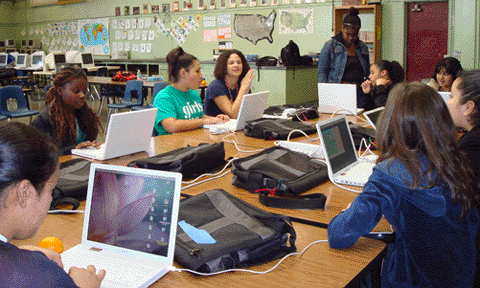Unit 5: Collaborative Game Design & Troubleshooting
Youth will experience the participatory design process as they work in teams to design a game for younger youth in the Girls Inc. program. Youth will receive instruction and opportunities to practice leadership skills. Youth will enhance their leadership abilities through practice, as they offer assistance, support, and team leadership. Youth will learn how to allocate resources–technology and human–and how to share and distribute knowledge among team members. In addition to leadership and collaboration skills, the youth will continue to explore computer science concepts in this unit, specifically object-oriented programming. Youth will present their projects at Family Tech Night. (one semester, after school; JourneyGirl level)
Big Ideas
- Collaboration involves a strategy for dividing tasks associated with a solution into pieces that can be worked on individually and reassembling the work products into a cohesive whole to form the solution (NRC, SCANS).
- Leadership involves teaching others new skills, communicating ideas to justify a position and convince others, and supporting a vision that may challenge the status quo (SCANS).
- To troubleshoot a problem in an information technology system, application, or operation, it is essential to have some expectation of what the proper behavior should be and how it might fail to be realized (NRC).
- Algebra: represent patterns in tables, with graphs and with symbolic expressions
Essential Questions
- How do you decide what to build?
- What is programming?
Download Curriculum
Using Scratch:
All of unit 5 for scratch (.pdf, 2.7 MB) file.
Scope and sequence for scratch (.doc, 159 KB) file.
Intro presentation (.ppt, 386 KB) file.
Activity pages (.doc, 2.6 MB) file.
Using Stagecast:
All of unit 5 (.pdf, 2.2 MB) file.
Unit 5 scope and sequence (.pdf, 144 KB) file.
Unit 5 starter kit for stagecast (.zip, 1.1 MB) file.
Activity pages (.doc, 3 MB). Word file that you can download to customize the handouts for Unit 5.
Intro presentation (.ppt, 386 KB) file.

Week 1. Programming vs Playing games. Youth play with educational games and begin programming in Stagecast.
Week 2. Learning Stagecast with Pond Life. Youth use coordinate geometry to understand how engineers and designers plan movement and location of characters.
Week 3. Researching and visiting Electronic Arts. Youth review design process and go on field trip to EA to learn about game design. Youth go on field trip to EA to learn about game design.
Week 4. Principles of Game Design & Stagecast Tutorial. Youth analyze 2 games to uncover principles of game design and they begin learning Stagecast formally.
Week 5. Designing the big game. Youth design and create map for the big game.
Week 6. Prototyping & Storyboarding Stages. Youth (in pairs) create a rapid prototype and then storyboard their stages.
Week 7. First week of Programming. Youth begin programming.
Week 8. Second week of Programming. Youth continue programming their games.
Week 9. Third week of Programming. Youth continue programming their games.
Week 10. Testing Stages + Fourth week of programming. Youth write instructions for their stages and provide feedback to other teams.
Week 11. Fifth week of programming. Youth continue programming their games.
Week 12. Sixth week of programming. Youth keep working on their games.
Week 13. Putting Humpty Dumpty back together again. Youth will design how the whole game will look, and how their separate games fit together.
Week 14. Prep for Family Tech Night. Youth will create and practice their presentations for FTN.
Managers/Coordinators/Director
 |
© 2013-2016 SRI International. 333 Ravenswood Ave. Menlo Park, CA 94205. Produced by the Center for Technology in Learning at SRI International with support from the National Science Foundation under Grant Nos. 1339181, 1232461, and 0524762. Any opinions, findings, conclusions, or recommendations expressed are those of the authors and do not necessarily reflect the views of the National Science Foundation. |

|

